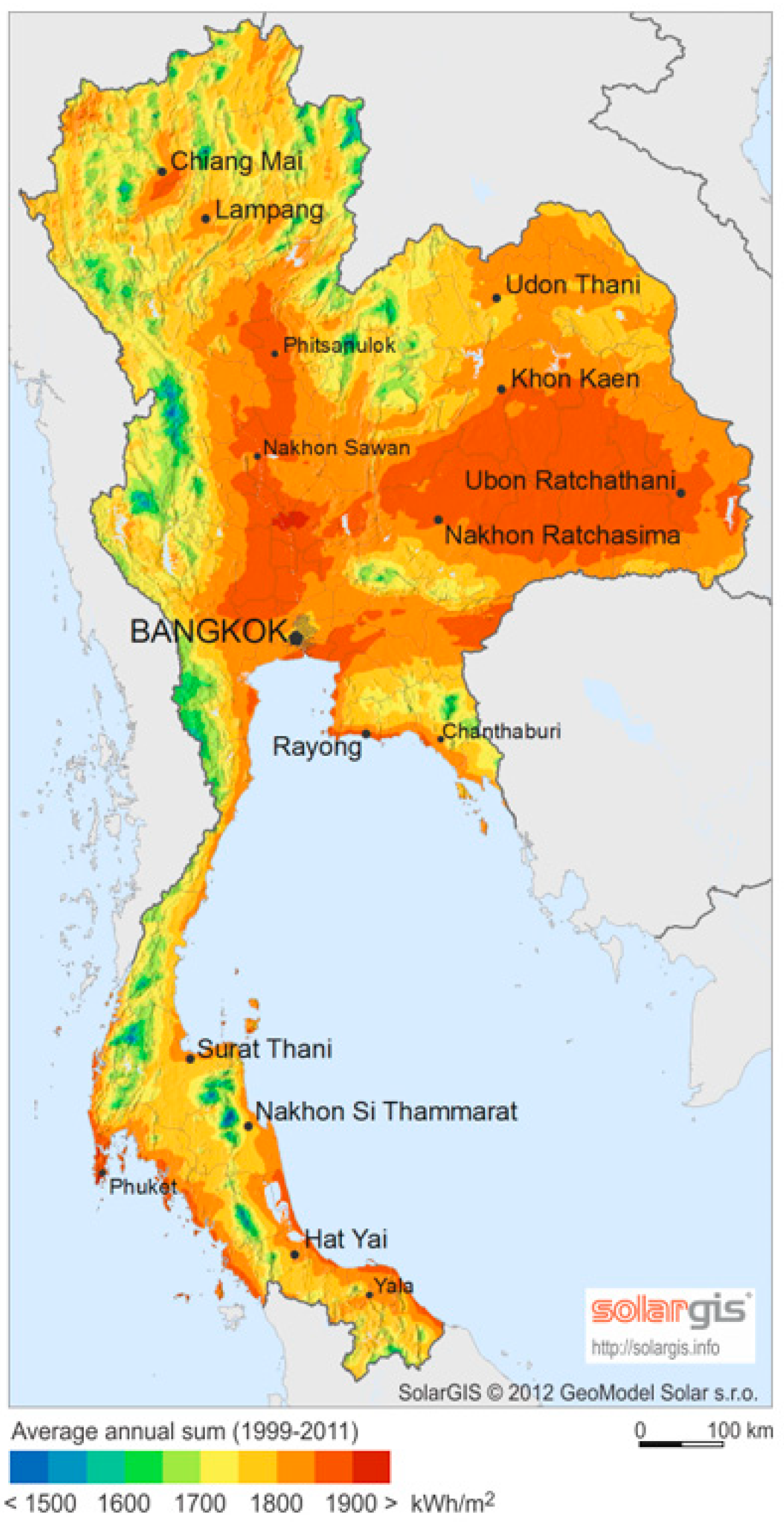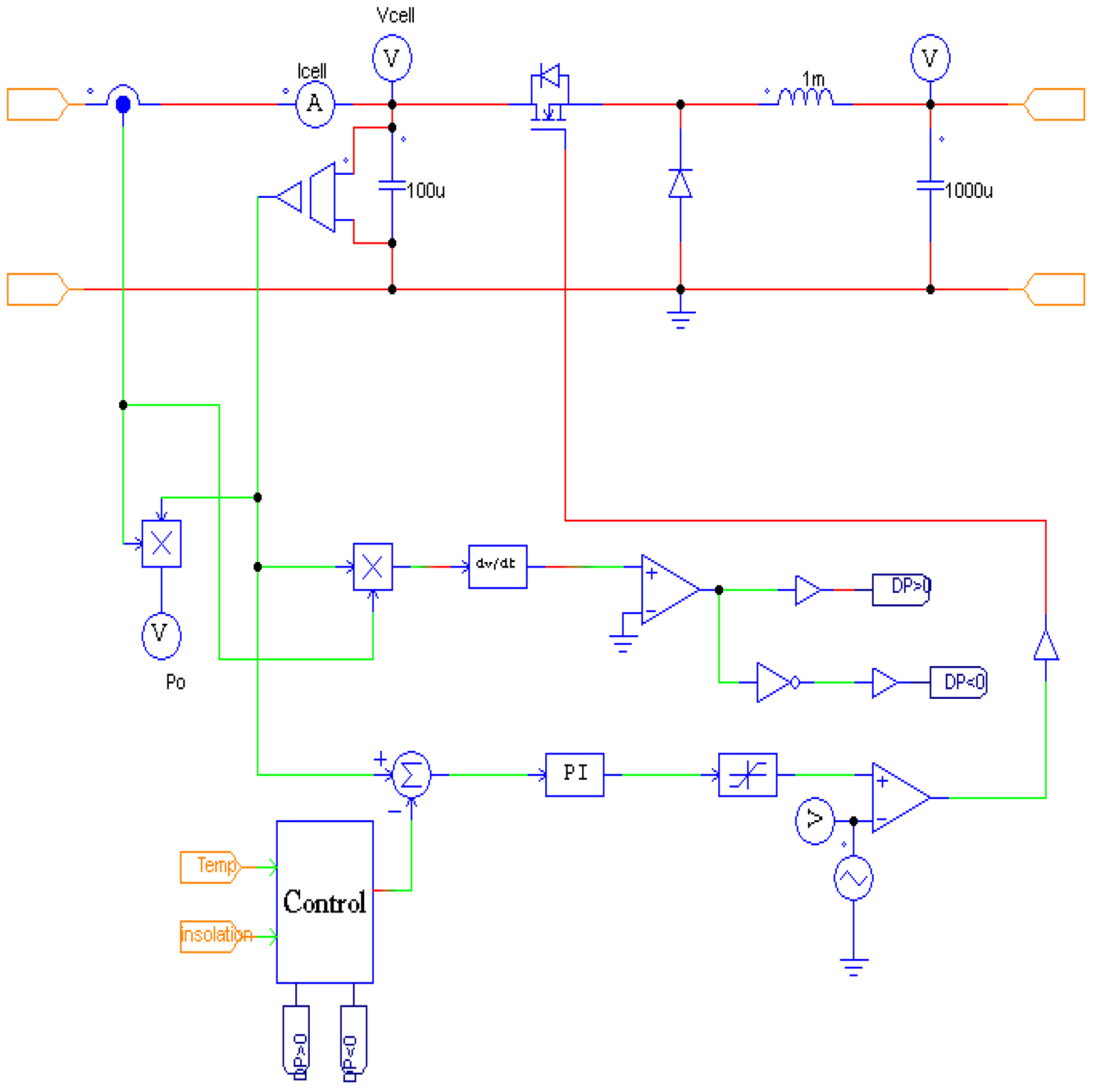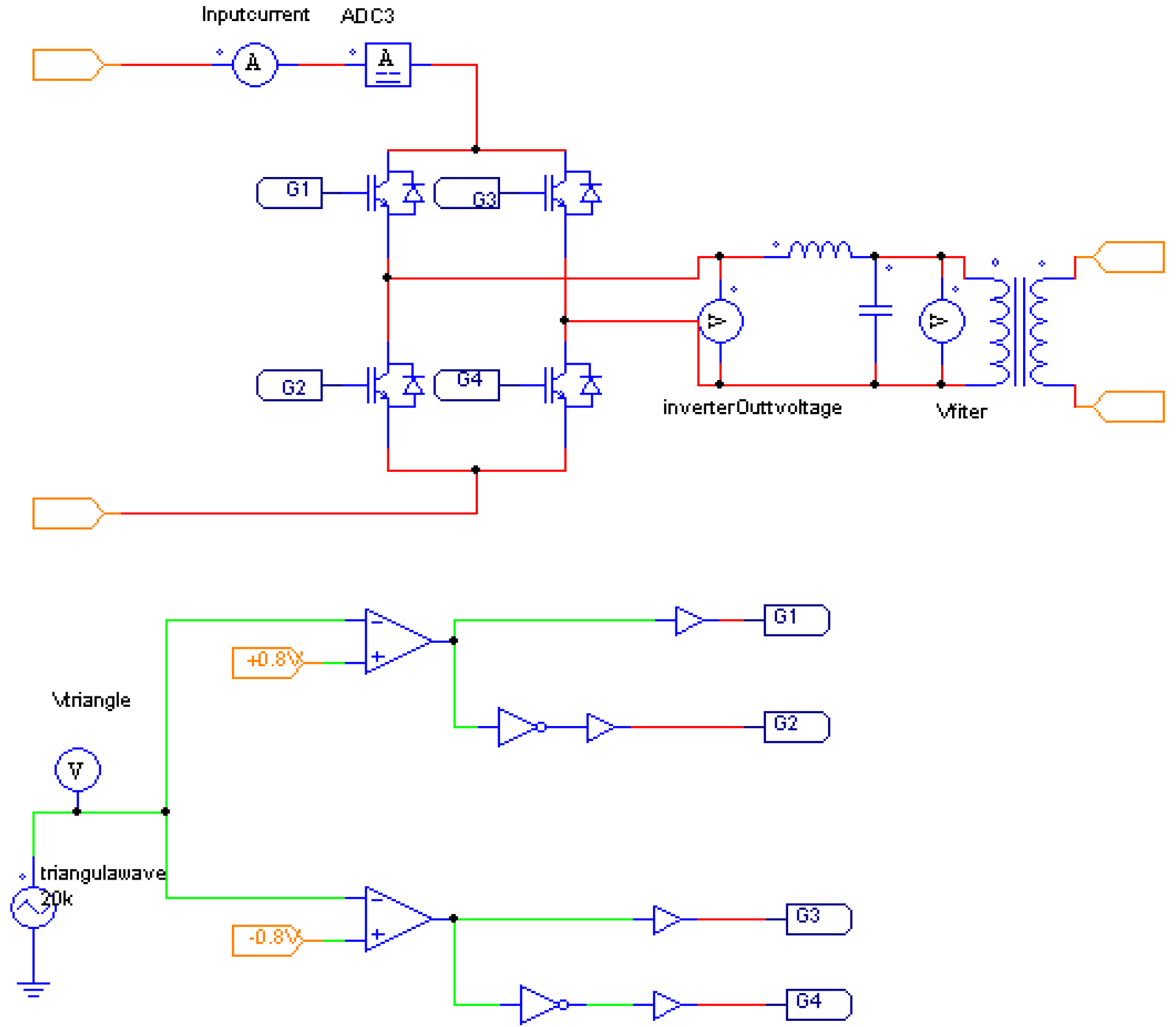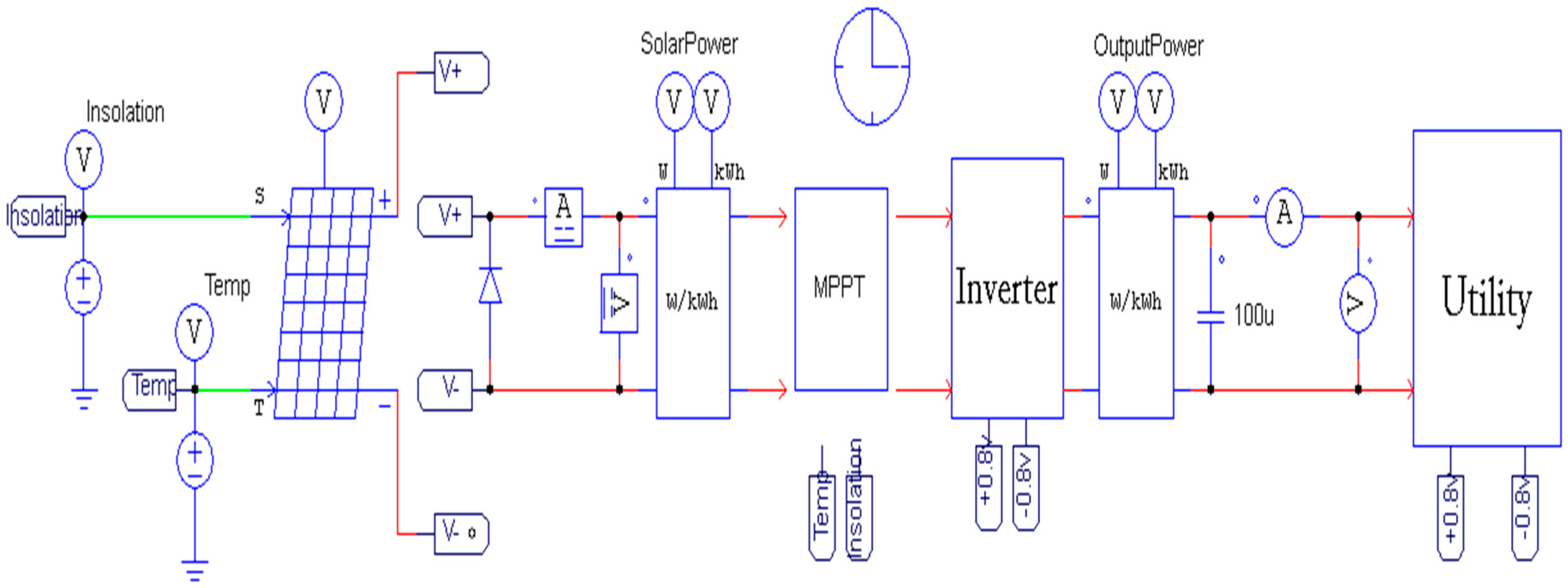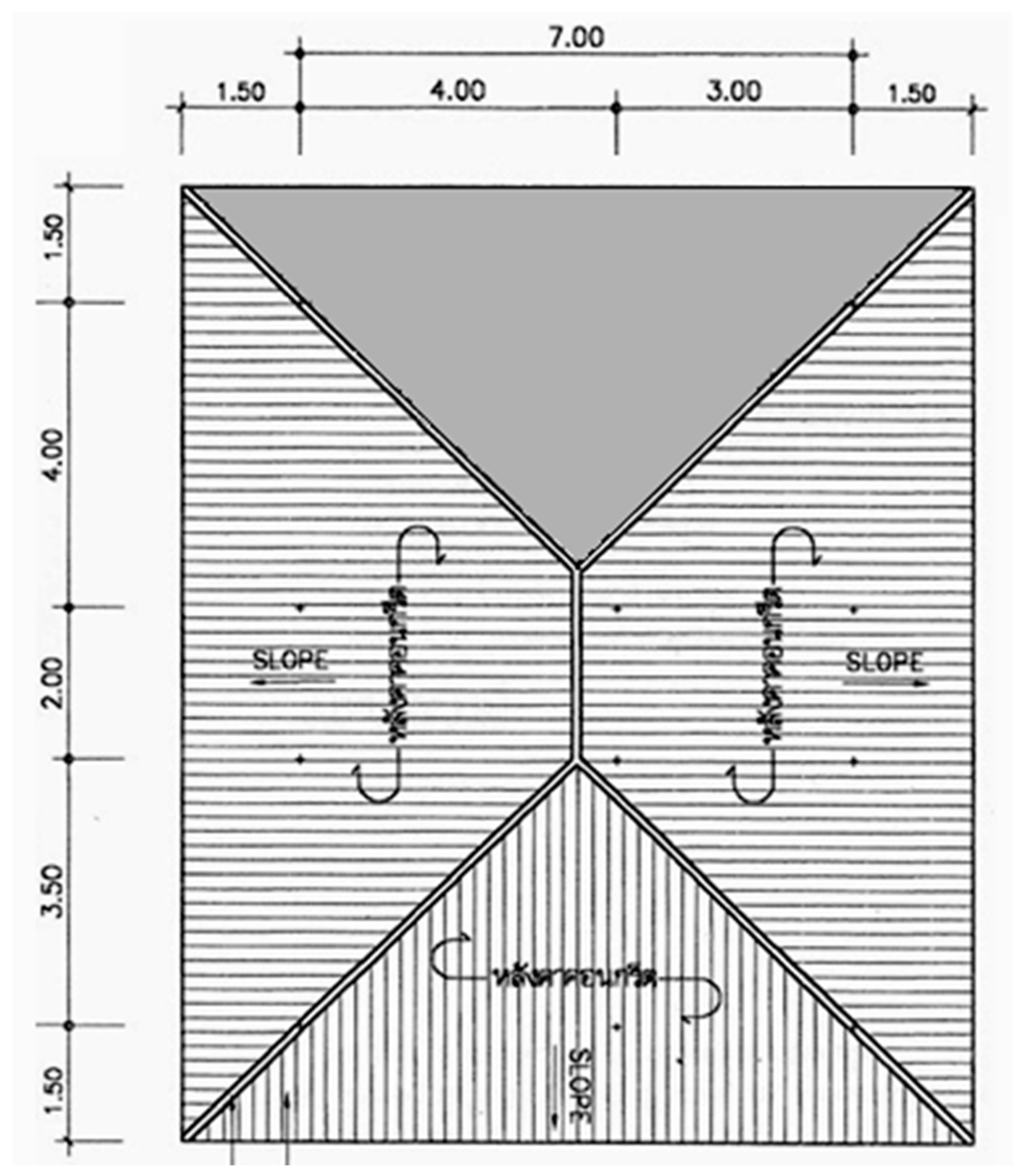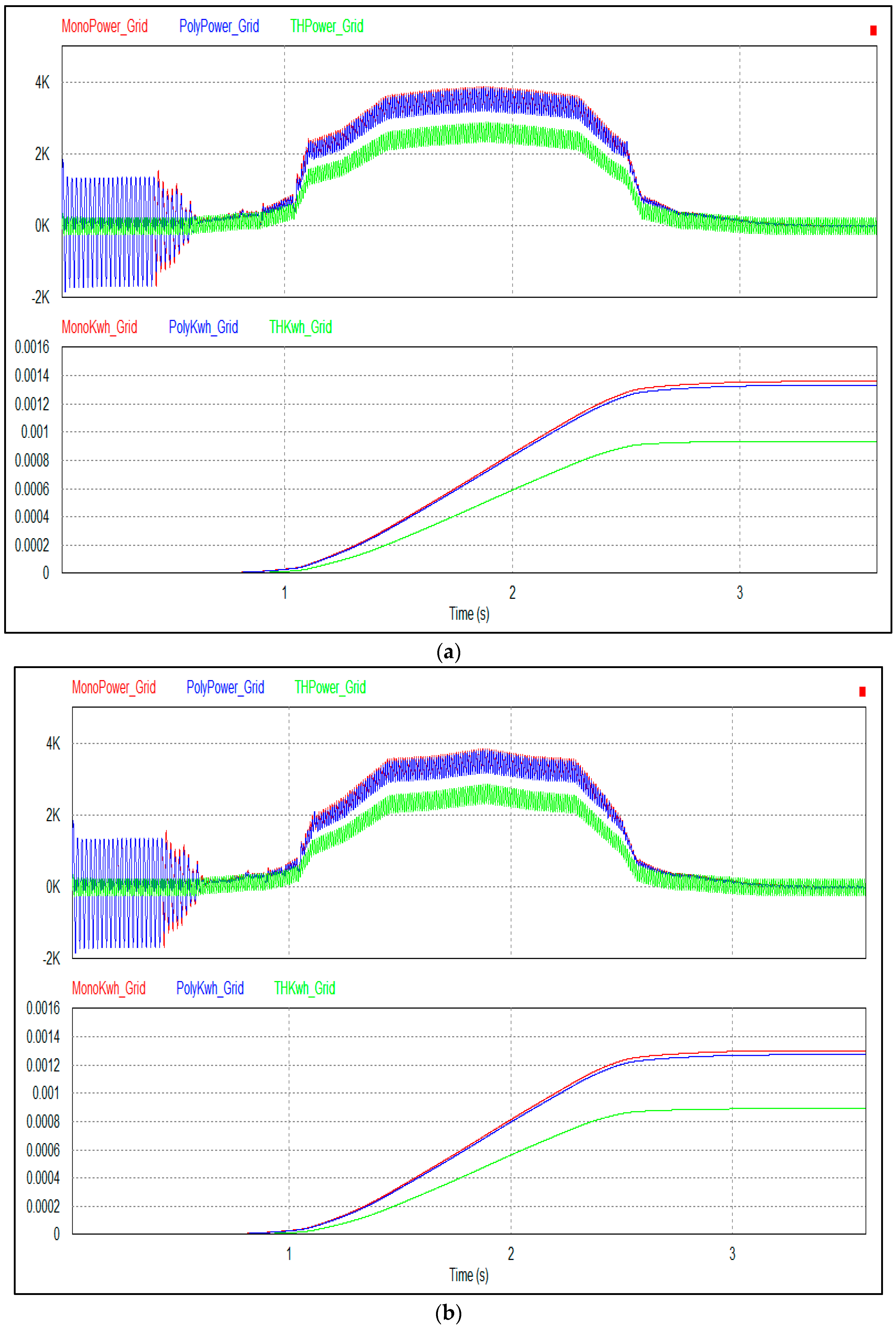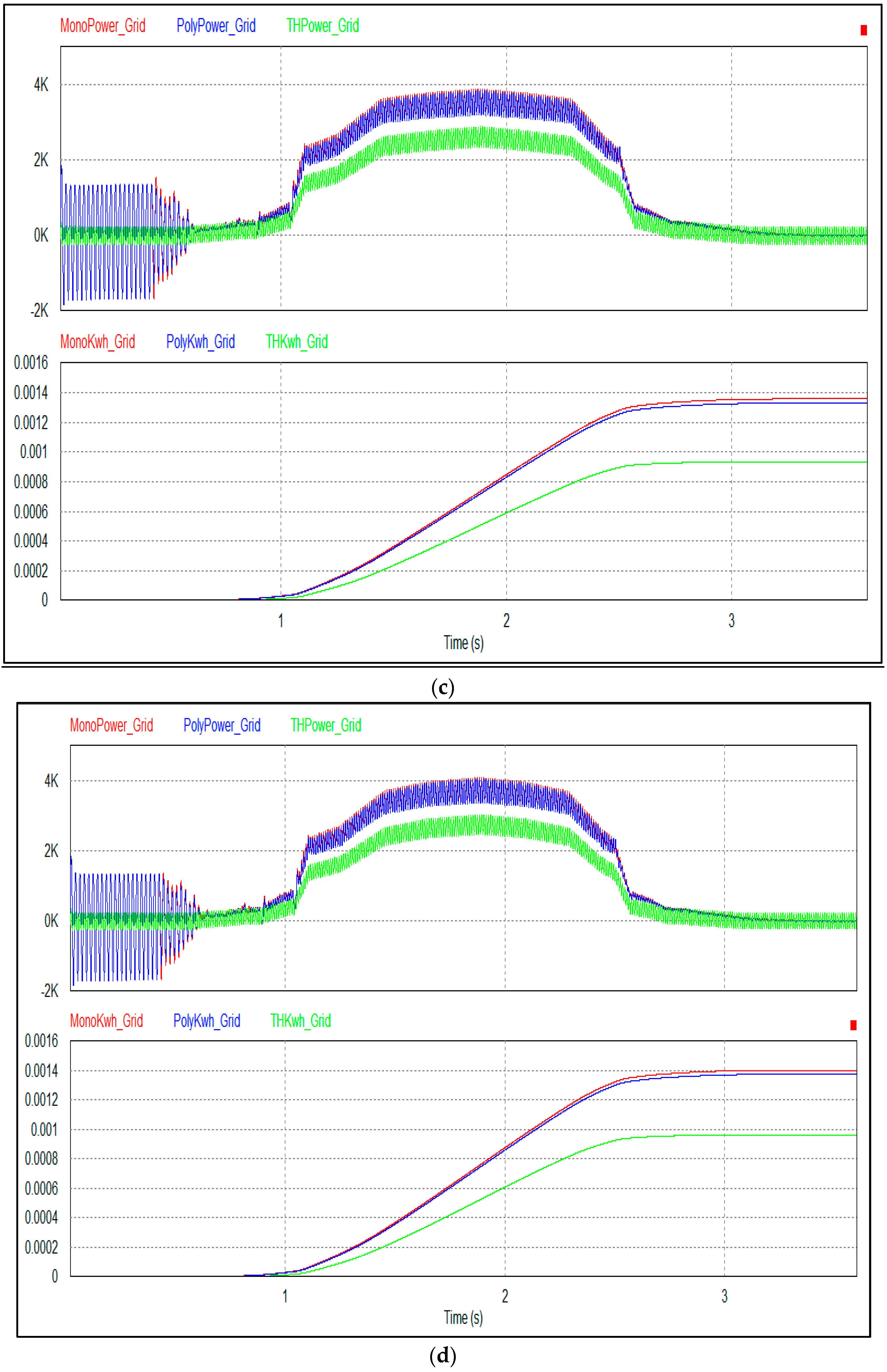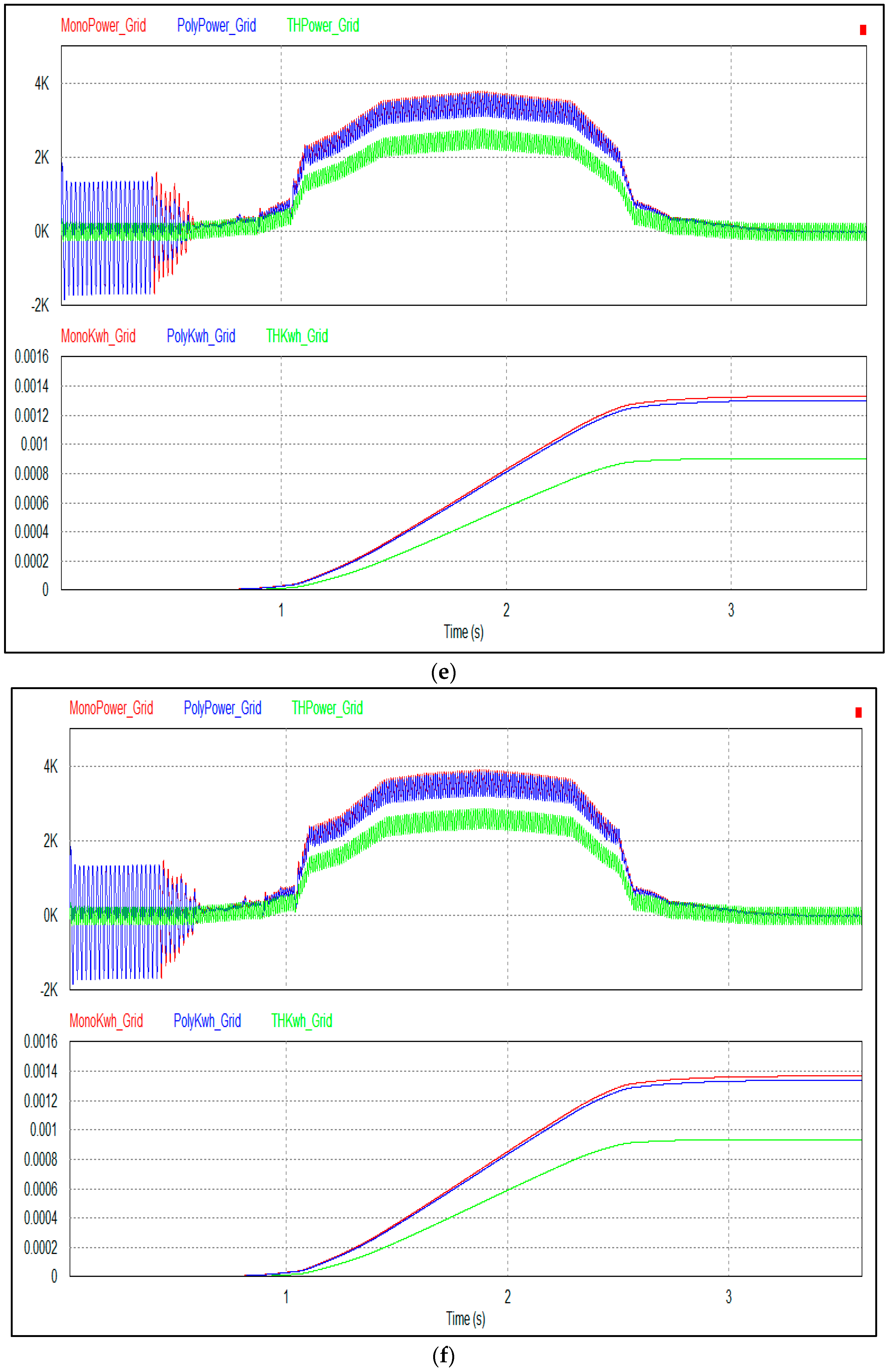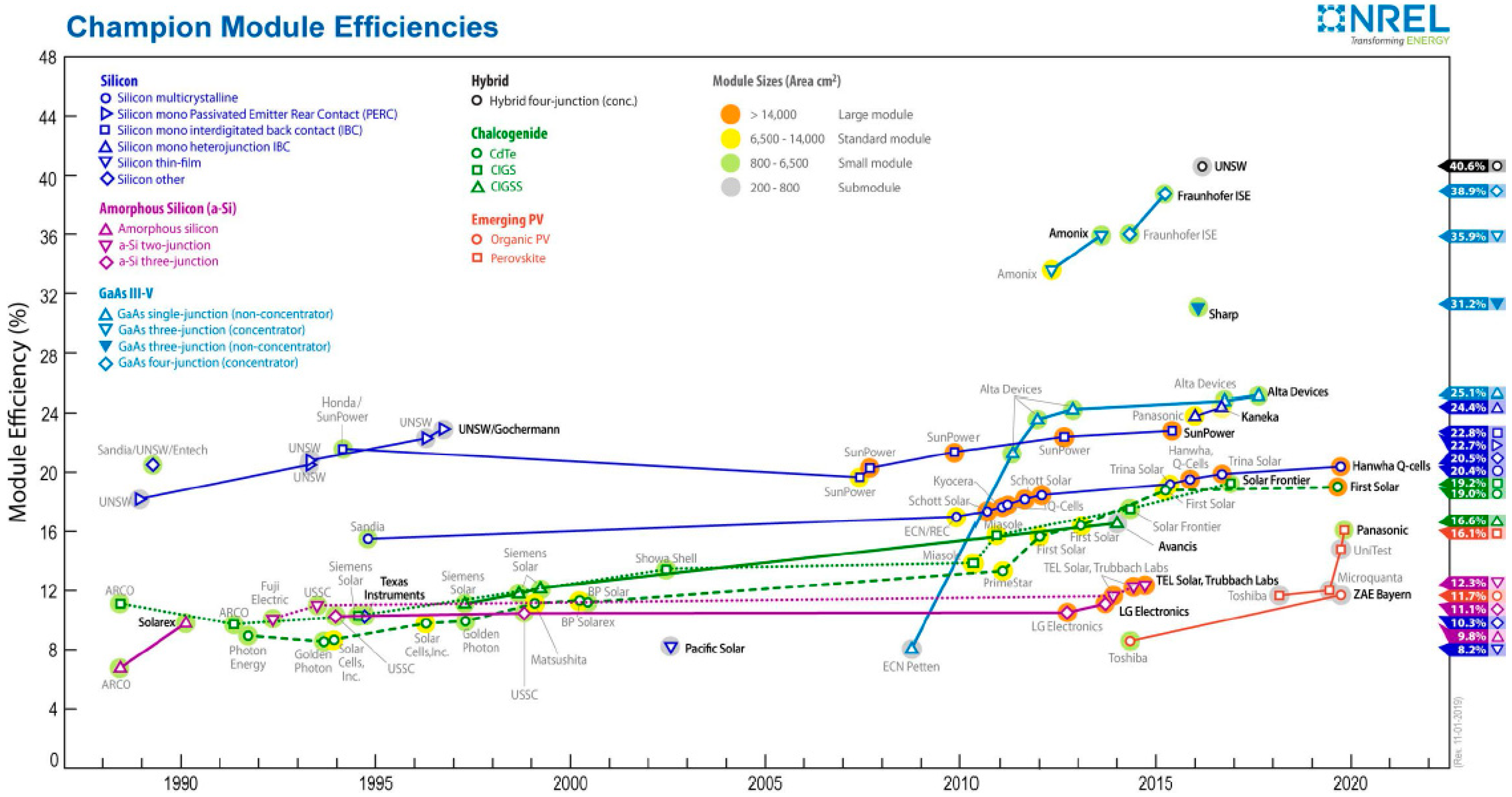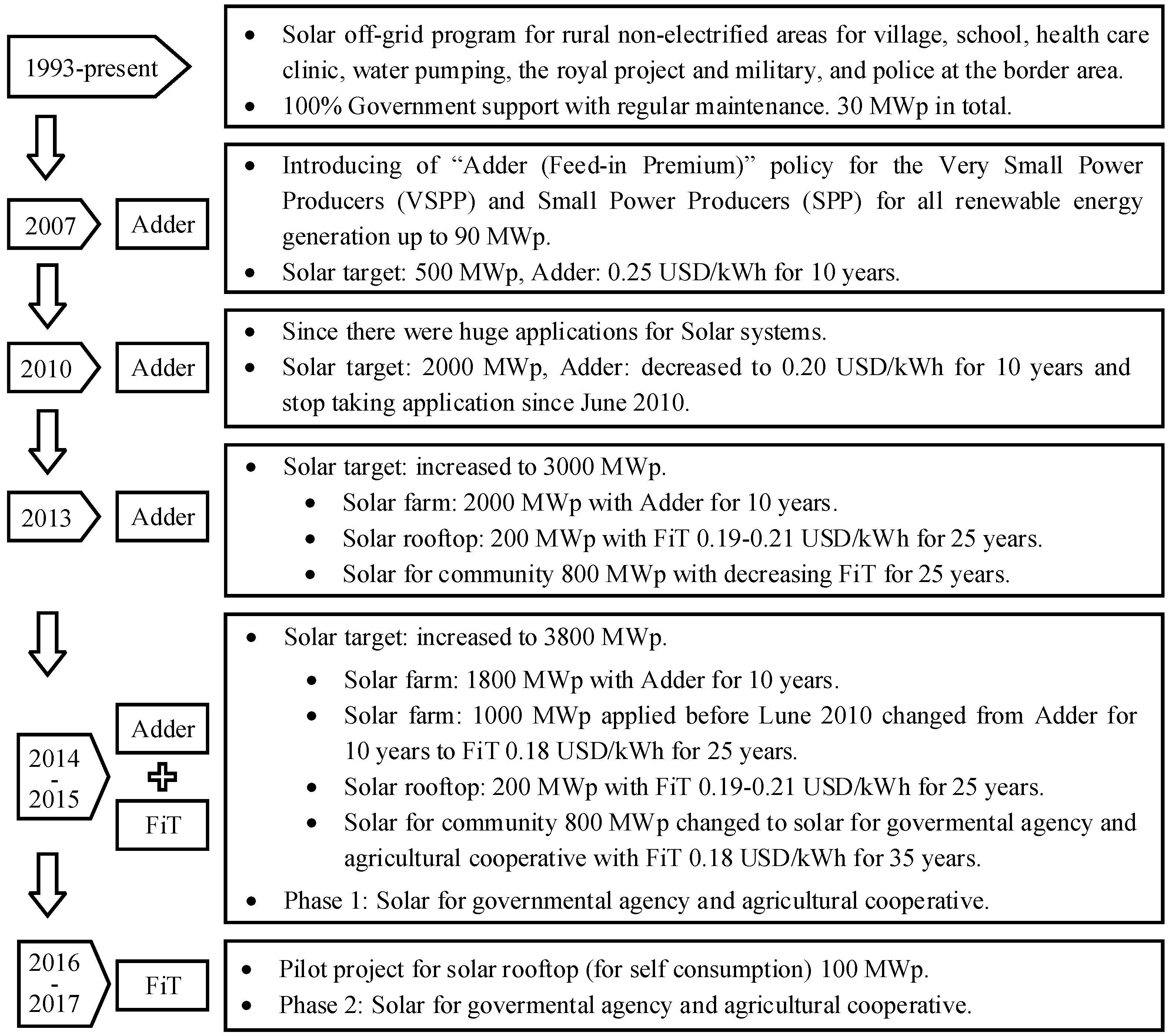1. Introduction
Electrical energy consumption in Thailand has continuously increased with the economic growth, industrial demand, air-conditioning consumption, increase in an electric vehicle as well as development in the country. In 2017, Thailand’s energy demand reached 185,124 GWh, almost all of which was produced from power plants using conventional fossil fuel, i.e., 60% from natural gas, 18% from coal, and 0.2% from oil [
1]. As an energy net-importer, Thailand has been aware of its need for energy security and has developed policies designed to decrease its dependence on fossil fuel for electricity production and increase its use of renewable energy sources. For this reason, renewable energy has gained much attention in these last few years with the current electrical energy consumption rate that has rapidly increased, and large-scale power plants cannot keep up with demand. Solar energy is one of the renewable energy sources that has rapidly grown in terms of capacity as Thailand is located in the tropical area and therefore contains an abundant solar power source, having great solar power potential, which is solar irradiation of 17–20 MJ/m
2 per day [
2]. Furthermore, solar power production is also supported by the government according to the Alternative Energy Development Plan (AEDP) and the Power Development Plan (PDP), which are the national renewable energy master plan. In this AEDP formulated in line with the PDP, the country is escalating the target of electricity capacity to 70,410 MW [
3,
4] with the installed capacity of renewable energy at 19,635 MW in 2036. Solar energy is the largest expected renewable energy source for electricity generation in the plan, with a target for an installed capacity of 6000 MW.
In the past, most solar systems invested in Thailand have come from utility-scale installations [
5]. However, due to solar system prices having a trend to decrease, the number of prosumers in other sectors, namely an industrial sector and a residential sector, has increased significantly. For this reason, solar rooftop systems in all scales of the solar system i.e., home, building, and industry, play a significant role in increasing the proportion of renewable energy production. Several research articles and case studies about solar rooftop systems in Thailand are reviewed in [
5,
6,
7,
8,
9,
10,
11,
12].
Tongsopit A. [
5] investigates the FiT scheme used in Thailand for the promotor of solar power generation and gives a feasibility analysis of solar rooftop system investment in a residential sector under three scenarios: NEPC assumptions, current market, and market stimulation. It is found that the residential FiT launched in 2013 is not strong and continuous enough to allow a significant market growth due to its short application period, lack of a widespread campaign, and complicated permitting processes. Furthermore, the author suggests that investment in solar rooftop systems for the residential scale can be motivated by a tax incentive given as discounts amounting to 20% of the investment cost. The situation of solar rooftop implementation, expansion, and execution strategies in Thailand are reviewed in Chaianong A. and Pharino C. [
6]. The three main topics of solar rooftop advantages based on successful international experiences and models, barriers of successful solar rooftop implementation, and recommendations to address existing gaps for solar rooftop investment. The results claim that the success of solar rooftop investment depends on collaborative works among the governmental, public, and private sectors with a clear understanding of the energy security issue that the country is facing. Moreover, the financial support policies of low-interest rate loans, production tax credits, schemes to support battery implementation, and renewable portfolio standards (RPS) have a successfully significant effect on solar rooftop promoting.
Business models and financing options for rooftop solar investment in Thailand are studied in Tongsopit S. et al. [
7]. Four kinds of solar rooftop business models: roof rental, solar power purchase agreement, solar leasing, and community solar are reviewed, including one type of financing option of solar loan is also identified. In addition, the drivers for solar rooftop emergence, barriers to solar rooftop investment success, and the risks from the viewpoints of owner and consumer are analyzed. Eskew J. et al. [
8] investigates the environmental impacts of solar rooftop installation and models the potential of solar rooftop systems to reach the country’s renewable energy goals. The results show that electricity generated from solar rooftop systems causes lower environmental impacts than fossil fuel-based electricity. However, the major contribution to impacts is in manufacturing by stage and from solar modules by component. Additionally, the mounting structure and inverters are also significant ones. However, domestic production of components and recycling of materials would reduce impacts. In this case study, there is an energy payback time of 2.5 years and a payback period of 7.4 years. In Tantisattayakul T. and Kanchanapiya P. [
9] paper, the economic evaluation of solar rooftop systems for the residential sector under a feed-in tariff scheme in Thailand is presented. Furthermore, additional appropriate encouragement measures, including an appropriate feed-in-tariff rate, personal income tax exemptions, carbon trading, and low-interest-rate loans for household investment, are proposed. It is found that the current scheme is not infeasible to promote solar rooftop investment in the residential sector under the current market situation. Among the additional supportive measures, the low-interest rate loan is the most outstanding measure for supporting and stimulating investment in the solar rooftop residential sector.
The situation of solar energy information for electricity production i.e., the potential of solar energy, solar energy status, and the barriers of solar-powered-system development in Thailand, including the global potential and growth of electricity production with solar energy is reviewed in Wongwises S. and Chimres N. [
10]. The information provides the benefit of the industry, investors, and people who intend to utilize solar energy to replace the fossil fuels in their businesses, encompassing the investment in electricity generation projects from solar energy. Chaianong A. et al. [
11] analyzes electricity bill saving of solar rooftop systems with different support programs: net metering and net billing for individual load profiles of four customer groups (residential scale, small general service, medium general service, and large general service). It is found that the electricity bill saving of all customer groups relies on electricity tariffs, solar system sizes, load characteristics, and details on the support programs. However, load characteristics hardly have an effect on the electricity bill saving. In addition, the use of the net metering program gives a smaller variation in the electricity bill saving compared to the other, leading to more flexibility for customers to size their solar systems. However, the net billing program cause encouraging customers to limit their solar system sizes, mitigating the concerns of several consumers about the oversizing of solar rooftop installations and the limitations of the utility grid. Furthermore, the same author also studies the economic feasibility of grid-connected solar self-consumption for four customer groups among three potential support programs: no compensation for excess electricity, net metering, and net billing [
12]. The economic evaluation is implemented by using the indicators of internal rate of return (IRR), net present value (NPV), and payback periods (PB). The results claim that entire customer class profit can be increased by using the programs. However, the net metering offers the most customer benefits. However, the authors recommend the net billing program for policy adoption since it is not only enough level of economic viability but also flexibility in dealing with broad stakeholders’ concerns.
These papers [
6,
7,
8,
9,
10,
11,
12] provide evidence and report challenges about the solar rooftop adoption model in Thailand in terms of economic feasibility, environmental impacts, FiT and execution strategies incentive scheme, and situation of solar energy information. It can be implied that solar energy can be a promising technology to help increase energy security and help transform Thailand into a sustainable society.
Not only in Thailand, solar system is more widely used technology and becoming more and more attractive especially with the solar rooftop systems in supply of the utility grid all around the world i.e., India [
13,
14], Pakistan [
15], United Arab Emirates [
16], Oman [
17], EU [
18], Switzerland [
19,
20], Uganda [
21], and South Korea [
22,
23]. Rathore S. [
13] studies various factors that have effects on the growth and development of the solar rooftop systems in India. Moreover, solar power policies supported the decentralized solar rooftop systems along with various business models and current status in India. Solar rooftop government policies & initiatives, the current status of the solar rooftop systems, key challenges, and various business models for the growth of the solar rooftop sector are also discussed. Finally, the international status of the solar rooftop systems, followed by some policy recommendations, is reviewed. Next, the feasibility of grid-connected solar rooftop systems for a household to supply the electricity in India is presented in Dondariya C. et al. [
14]. The various simulation software of PV*SOL, PVGIS, SolarGIS, and SISIFO is carried out to analyze the performance of the considered solar rooftop systems. In addition, the index of energy generation, performance ratio, solar fraction, and energy yield for performance prediction of the systems is also evaluated. It is found that the PV*SOL software is easy, fast, and reliable for the simulation of solar rooftop systems. In Pakistan, Khan J. and Arsalan M. H. [
15] present methods to combine geographic information systems (GIS) and object-based image recognition approach to identify the available rooftop area for solar installation. Six step techniques are used to estimate solar rooftop potential, which is a geographic division of high-resolution satellite imagery, sampling rooftop feature extraction, analyzing different rooftop factors, comparing the extracted rooftops to another rooftop, and conversion of energy into power outputs.
Due to changing hydrocarbon markets in the Middle East and North Africa (MENA), the solar system technology trends to rapidly falling prices, leading to solar power increasingly attractive. Hence, their energy systems are away from dependence on hydrocarbon fuel sources. For this reason, using solar energy, especially in solar rooftop systems, is being positioned to play an essential role in the United Arab Emirates (UAE) [
16]. Griffiths S. and Mills R. [
16], the solar rooftop situations in UAE are studied for the evolution of a MENA energy system. It is found that solar rooftop installation in UAE can be an economically viable technology choice, and it will become part of regional energy strategies. In Oman, Al-Saqlawi J. et al. [
17] implements a new approach to evaluate the potential of using solar rooftop with battery technologies that operate without recourse to the utility grid. The proposed technique is a technical assessment of stand-alone systems which assesses the characteristics of the solar panel and the battery facility required to provide stand-alone systems. After that, the considered systems are compared to similar grid-connected systems and any techno-economic targets necessary to enhance the feasibility of residential solar rooftop systems using a mathematical model. The simulation is dealt with in the gPROMS program based on real hourly weather and climate conditions matched with real demand data. The results show that stand-alone solar rooftop systems are infeasible. However, supporting high electricity prices and reducing battery prices can be economically feasible.
Bódis K. et al. [
18] uses earth-observation geospatial data from a geospatially explicit methodology using up-to-date spatial information for calculating the rooftop areas and technical potential for solar electricity production over the whole of the EU. Statistical data sources with machine learning are combined with satellite-based to achieve a reliable evaluation of the technical potential for solar rooftop power generation. The economic assessment in the term of levelized cost of electricity (LCOE) based on country-specific parameters and the comparison of household electricity prices is dealt with. Buffat R. et al. [
19] presents the long-term potential of solar irradiation over solar rooftops in Switzerland using a generic method to calculate solar irradiation potential on rooftops over large regions. Moreover, corresponding unpredictability estimation when the long-term electricity generation of solar systems is calculated is also investigated. Suitable surfaces on rooftops are identified using digital surface models combined with building footprints in order to determine rooftop geometry, namely slope, and orientation. Assouline D. et al. [
20] employs a computational methodology combining Geographic Information Systems (GIS) data processing and a machine learning method (Random Forests) to estimate solar rooftop potential in Switzerland. The suitable installation of solar panels on rooftops is estimated in each grid pixel of electricity production by following the constraints of incoming solar radiation, the roof shapes, roof superstructures, tilt and direction of roofs, available rooftop areas for solar installations, shading effects, and efficiency of solar panels. It is found that Switzerland provides great potential for solar rooftop installation.
An alternative technique to determine rooftop areas suitable for solar deployment in Uganda by using validated open-source tools i.e., namely, Google Earth and Pitch and Azimuth tools are presented in Mukisa N. et al. [
21]. Additionally, the economic feasibility of proposed grid-tied solar rooftop systems in the industrial sector is evaluated. The study results show that the energy generation potential of all solar roof orientations and tilt angles in the range 0°–45° is possible, which provides annual energy yield in the range of 1046 kWh/kW–1344 kWh/kW. For economic aspect, the solar rooftop systems, which are short loan period of 5 years being still feasible when the loan share of investment cost reached up to 75%, cause an LCOE of 5.75 US cent/kWh, internal rate of return of 7% and BCR of 1.27. Lee M. et al. [
22] proposes a methodology for estimating the economic potential of solar rooftop systems in South Korea based on a bottom-up approach. Solar rooftop profitability is calculated using various technique i.e., life cycle cost analysis and Hillshade analysis, along with actual building data. Furthermore, the market conditions of installation cost, policies and support program, and electricity costs, which vary over time, are considered for the economic evaluation of solar rooftop systems. Lee M. et al. [
23] proposes a technique for developing solar rooftop systems in South Korea using cluster analysis based on technical and economic suitability criteria. Additionally, two cluster analysis of hierarchical cluster analysis (HCA) and k-means clustering is used to validate statistical approaches for developing solar rooftop systems. This study provides significant contributions for solar rooftop suitability information for intuitive decision-making based on scientific evidence and reasonable criteria.
This paper presents the performance evaluation of solar rooftop systems in the residential sector installed in different regions of Thailand using PSIM simulation. Solar rooftop installation comparison in different regions is carried out to evaluate the suitable location. In addition, three different types of solar panels are used in research. The electrical parameters of real power and energy generated from the systems are investigated and analyzed. Furthermore, the economic evaluation of different solar rooftop system sizes is investigated. The rest of this paper is arranged by
Section 2 present solar system situation in Thailand. The simulation is presented in
Section 3. In
Section 4, the simulation results are shown and discussed. The economic evaluation is dealt with in
Section 5. The discussion is presented in
Section 6. Finally, the conclusion is presented in
Section 7.
2. Solar System Situation in Thailand
According to the long-term Energy Master Plan of Thailand (2015–2036), the Alternative Energy Development Plan (AEDP) formulated in line with the Power Development Plan (PDP) is released by the ministry of energy. These plans focus on raising the target of electricity capacity to 70,410 MW [
3,
4] with the installed capacity of renewable energy at 19,635 MW in 2036. Solar energy is the largest expected renewable energy source for electricity generation in the plan, with a target for an installed capacity of 6000 MW.
The solar rooftop systems aim to produce and employ the electrical energy at the installation area due to the loss of transmission and the fact that the installation areas are smaller than the solar power plants. Many factors can affect power produced by solar rooftop systems, such as the direction of sunlight, climate, temperature, solar radiation. The solar irradiation average in Thailand is presented in
Figure 1. It is found that 14.3% of the country gains average daily solar exposure at around 19–20 MJ/m
2 per day, while the other 50% of the country demonstrates around 18–19 MJ/m
2 per day. Moreover, 0.5% of the country has less than 16 MJ/m
2 per day [
2]. As a result, Thailand has the potential to produce electrical power from solar energy throughout the country, suitable for investment in solar systems.
Solar rooftop systems in Thailand have recently gained much attention from investors owing to the recent policy from the Thai government, named “Feed-in Tariff (FiT).” This program supports community and residents to install a solar system on their roof to further increase the solar rooftop capacity of the country. As shown in
Figure 2, the first FiT program was a premium FiT scheme called Adder, which is a premium rate paid on top of the normal tariff of electricity, which varies over time. However, the adder rate for solar schemes is equal to every solar system capacity. It cannot reflect on the actual investment costs of the projects, which usually rely on the solar system size. For that reason, the adder scheme is replaced with a fixed FiT. The first solar rooftop FiT policy for the country was set up in 2013 with a target of 200 MW, dividing to commercial rooftops (10–1000 kW) and 100 MW of residential (0–10 kW) rooftop systems [
24]. The support duration is 25 years from a commercial operation date. However, in 2015, regarding the AEDP, the new target of the solar system in Thailand was 6000 MW, but the new incentive for the solar rooftop was holed at the FiT 2013 [
9].
It is found that there are three types of solar panels (monocrystalline, polycrystalline, and thin-film) that are commonly used in the solar rooftop systems, which have different advantages and disadvantages as shown in
Table 1. However, the thin-film is not very popular nowadays due to its less efficient than the other types. As a result, the former is not widespread in terms of commercials.
Installation prices per watt of various solar system categories are shown in
Table 2. The solar system prices rely upon the system size and type of installation: the solar rooftop system and the solar farm system. The solar rooftop price is in the range of 1.9–2.4 USD/W, depending on the product’s guarantee and after-sale service contracts [
25].
3. Simulation
The simulation of this research is carried out by using PSIM software, the studied system principally consists of a solar rooftop system, a grid-tied inverter, and utility. The power produced from the solar rooftop system, controlled by using maximum power point tracking (MPPT) technique, is directly fed into the grid utility, single-phase voltage of 220 volts and frequency of 50 Hz, vie a grid-tied inverter. Measurement of current and voltage from the grid utility of each solar rooftop system is implemented by using simulation to analyze and compare their efficiency. The simulated results issued from three different types of solar panels, which are monocrystalline, polycrystalline, and thin-film, are compared in terms of efficiency for power system generation. The simulation will be done for six regions (the North, Central, East, Northeast, West, and South) in Thailand, where there are different temperatures and radiation.
In the simulation, maximum power point tracking (MPPT) is utilized due to power generated from solar rooftops having fluctuated behavior characteristics dependable on weather conditions. The MPPT lets the solar rooftops to produce maximum power at their output and thus increases the system efficiency.
Figure 3 presents the MPPT control modeling. It sets a suitable duty cycle value at the gate of an insulated-gate bipolar transistor (IGBT) switch employed in a DC-DC buck converter so that maximum power can be extracted. MPPT tests for dV/dT to be zero. If the sum is not zero, the Proportional Integral (PI) controller treats the sum as error and minimizes this error. The obtained value at the output of the PI controller is the change in duty cycle value. The DC-DC buck converter is utilized to decrease and regulate the output voltage of the solar rooftops and to implement maximum power point tracking as well.
Single-phase grid-tied inverter is used to convert direct current power into alternating current power. A model block used for this purpose is presented in
Figure 4. A triangular waveform signal is used to create the graded signal of the IGBT for switching on and off periods. The grid-tied inverter generates single-phase sinusoidal voltage and current. However, the current generated from the grid-tied inverter has encompassing harmonic distortion. Thus, the LC filter at the output of the grid-tied inverter is implemented to decrease inverter current harmonic distortion. In this study case, the frequency of 50 Hz is selected as a cut off frequency of the filter. The complete single-phase grid-tied solar rooftop system is shown in
Figure 5.
The installation and area of the solar rooftop is an important key to be considered because these factors have a direct influence on electrical power generated from a solar system. The area rooftop used in the study case is shown in
Figure 6.
In
Figure 6, a solar rooftop installation in the south is an area in the shade. From the data, the calculated area average is equal to 0.5 × 10 × 6.714 = 33.57 m
2. The maximum area able to be installed is 33.57 × 0.85 = 28.53 m
2. 250-Wp solar panels, which are the dimension of 1640 mm × 992 mm × 40 mm, are employed. Therefore, the solar panels of 16 panels, which are connected in series and parallel in order to increase voltage and power, are installed on the rooftop. Hence, there is a solar power of 4000 Wp.
5. Economic Evaluation
From the simulation results, it is found that the use of monocrystalline and polycrystalline modules can produce the most electrical energy, resulting in high energy efficiency. However, although the energy produced from solar energy is clean and abundant energy, the system cost is high. Thus, the installation cost of the solar rooftop system must also be taken into account. The solar rooftop system has high energy efficiency but high installation cost, which is less attractive for consumers. Therefore, the economic evaluation of the solar looptop installation is an important point of view. In this section, the economic evaluation of different solar rooftop system sizes using the monocrystalline module is investigated by using economic indicators of discounted payback period (DPP), net present value (NPV), internal rate of return (IRR), and profitability index (PI).
The cost of solar rooftop systems, operation & maintenance cost, financial mechanism, FiT rates of the solar rooftop systems based on
Figure 2 is used to evaluate economic feasibility in the term of solar rooftop system owner’s perspective. The economic evaluation is implemented based on the assumption of Thailand’s geography, which is a tropical climate located near the equator. For this reason, this location obtains a great number of solar irradiance as a result of high solar generation performance, with an average 1000 W/m
2 for roughly 4.8 hours per day. The used economic study is dynamic methods to account for time values of money by discounting the cash inflows of the project, which is discounted payback period (DPP), net present value (NPV), internal rate of return (IRR), and profitability index (PI).
5.1. Discounted Payback Period (DPP)
The DPP is used to determine the profitability of a project, which gives the number of years that takes to break even from undertaking the initial investment cost, by discounting future cash flows and recognizing the time value of money. The acceptable DPP must be shorter than the service life of a project.
DPP is the period for which annual total saving cost per year (A) is equal to initial investment cost (
I0). If all annual cash inflows are equal the DPP calculation is shown in Equation (1) [
26].
This equation can be solved for DPP to give in Equation (2).
where:
I0 is the investment cost at the beginning.
A is Annual Total Saving cost per year.
i is the discount rate: 3% (average value in the inflation rate of Thailand).
5.2. Net Present Value (NPV)
The NPV of an investment project is the sum of the present values of all cash inflows and outflows of the investment. A project is profitable when NPV > 0, and the higher the NPV, the more profitable. By contrast, if the NPV is negative, a minimum interest rate will not be met. The NPV for the discount rate of all cash flows can be calculated from Equation (5).
The Equation (3) can be rewritten as:
For constant annual total saving cost per year (A), the NPV is a finite geometric series and is given by
where:
5.3. Internal Rate of Return (IRR)
The IRR of an investment project is utilized to estimate the profitability of potential investments, which can calculate from a discount rate that makes the NPV of all cash flows from a particular project equal to zero. Thus, the IRR calculations depend on the same formula as the NPV does. The higher percent of the IRR, the more achievable interest tied-up in the investment.
However, Equation (6) illustrates a manifestation of the complex problem of finding the IRR due to the roots. According case studies, the IRR is considered based on 25 years. Thus, it cannot solve the equation with hand calculations. For this reason, calculating the IRR can be done in Excel software for all case studies.
5.4. Profitability Index (PI)
The PI is the measurement of the ratio between the present value of future cash flows and the initial investment. If the PI is greater than 1, the project is satisfied for investigation. By contrast, the project is not an economic benefit when the PI is less than 1. Hence, the greater the PI value, the more attractive the investment. The equation for PI is as follows [
27]:
The economic parameters of solar rooftop systems used in case studies are presented in
Table 4. Solar rooftop systems are installed in Thailand which has an average 1000 W/m
2 for roughly 4.8 hours per day. In case studies, the solar rooftop system sizes are varied from 2.4 to 9 kW. The project periods and discount rates used for economic evaluation are 25 years and 3% respectively. Solar rooftop system costs comprising the costs of solar panels, inverters, etc. are calculated from average installation prices of general solar system applications in Thailand for solar rooftop systems up to 10 kW as mentioned in
Table 2 [
25]. For that reason, the costs of solar rooftop system used in case studies are 2.1 USD/W.
The annual cost of operation and maintaining (O&M) of a solar rooftop system is normally minimum and set at 0.68% of the initial investment cost [
5]. In order to evaluate economic feasibility, the annual revenue is calculated from using the FiT scheme for solar rooftop systems of 0.21 USD/kWh as shown
Figure 2 [
9,
24]. However, solar rooftop systems that are installed without FiT scheme have the main function to reduce energy consumption from the utility grid, in which the electricity cost in Thailand is 0.125 USD/kWh. The degradation rate of 1% per year was used as assumption.
Table 5 and
Table 6 present installation costs and economic evaluation results of different solar rooftop installation sizes using monocrystalline modules for using FiT scheme and without FiT scheme respectively. Initial installation costs are calculated from the costs of solar panels, inverters, and others. The costs of solar rooftop systems depend on the sizes of the systems. O&M costs are considered from the initial installation costs, which is used to estimate expense for system maintenance each year. Additionally, O&M costs are not expensive for the solar rooftop systems, since the systems have small capacity as well as the equipment is durable and has a long lifetime. Energy production per year is the electrical energy produced from the solar rooftop systems in the periods of 365 days based on average solar irradiance of 1000 W/m
2 for roughly 4.8 hours per day. Annual revenue is calculated from the costs of energy production per year based on FiT or without Fit rates subtracted with the O&M costs per year. In economic evaluation, the degradation rate of 1% per year is implemented, caused by the degradation rate of solar panels, the amount of dust, and inverter efficiency reduction.
Economic results show that the sizes of solar rooftop systems have an effect on high installation costs. The greater the solar rooftop system installation sizes, the higher the installation costs. However, the more the higher installation costs, the more the greater the average produced power per day, hence a great number of annual revenues. Thus, all the solar rooftop installation sizes provide similar DPP, IRR, and PI values. The increase in installation costs of solar rooftop systems is consistent with the increase in energy produced from them, leading to the proportion of installation costs and annual revenue being equal to each year. By comparing the solar rooftop systems between with FiT scheme and without the FiT scheme, it is found that the former gives better economic results which are shorter DPP, higher NPV, more IRR, and better PI. However, a large-scale installation of solar rooftop systems gives a higher NPV since all solar rooftop system sizes have the same DPP of 6.1 years, meaning that the solar rooftop systems having a profit for solar rooftop own’s in 6.2 years. For this reason, large-scale solar rooftop systems are more profitable after their payback by comparing the NPV values of 9 kW solar rooftop sizes and 2.4 kW solar rooftop sizes. Although the solar roof systems have a high installation cost, the installation of solar rooftop systems has economic feasibility for a project lifetime of 25 years due to support from the FiT scheme.
6. Discussion
This study focuses on the comparison of electrical energy production from solar rooftop systems using 3 different types of solar panel technologies i.e., polycrystalline, monocrystalline, and thin-film. In fact, the technology of the solar panels will have a major effect on the produced electrical power. Recently, solar panel technologies are continuously explored and developed as shown in the timeline of technologies in
Figure 9.
Most solar modules are currently produced from crystalline silicon (polycrystalline and monocrystalline silicon.) due to high efficiency and their prices tend to decrease. In addition, Rühle S. article claims that crystalline silicon devices of single p–n junction based on Shockley–Queisser limit are now approaching the theoretical limiting power efficiency of 33.16% [
29]. The rest of the overall market is made up of thin-film technologies using cadmium telluride, copper indium gallium selenide (CIGS) and amorphous silicon. The thin-film and amorphous silicon technologies still give lower efficiency than the silicon. However, they provide outstanding benefits for higher efficiency in different climatic conditions and lower production costs [
30].
Emerging photovoltaic is third generation solar technologies that use advanced thin-film cells i.e., organic photovoltaic [
31] and perovskite [
32,
33]. Ana M. et al. work [
31] presents that the performance of organic photovoltaic in a term of module performance ratio is similar to some of the most common technologies. Different compositional perovskite materials for solar cells are reviewed in L. Yan et al. [
32] and Parida B. et al [
33]. It is found that organic photovoltaic technology may be a good alternative candidate for solar deployment due to their relatively high-efficiency conversion and the low cost compared to other new solar technologies. However, they are still less efficient than crystalline silicon.
Gallium arsenide (GaAs) solar cell technologies provide the highest efficiency as well as their highest costs [
34,
35]. GAGS Multi-junction cells which are compound semiconductors and made of GaAs and other semiconductor materials are preferably used in solar panels on spacecraft since they give the greatest ratio of generated power per kilogram lifted into space.
However, the use of high-efficiency solar panels may not be appropriate for solar rooftop systems since they are expensive, resulting in not being economically worthwhile. In addition, some of the solar panel technologies are in the research and development stages. Thus, there is not widespread in the term of the commercial market. From another perspective, the shape of the roof does not have any significant impact on the production of electrical power in the solar rooftop system due to the electrical power produced depending on the solar irradiance, temperature, tilt angle and direction of the solar panel installation.
